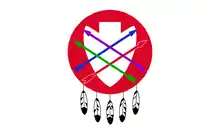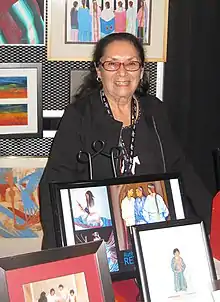Peoria people
The Peoria (or Peouaroua) are a Native American people. Today they are enrolled in the federally recognized Peoria Tribe of Indians of Oklahoma. Historically, they were part of the Illinois Confederation.
 Tribal Flag | |
 Ruthe Blalock Jones, Peoria-Shawnee-Delaware artist | |
| Total population | |
|---|---|
| 2,925[1] | |
| Regions with significant populations | |
| Languages | |
| English, formerly Miami-Illinois | |
| Religion | |
| Christianity (Roman Catholicism), traditional tribal religions | |
| Related ethnic groups | |
| Kaskaskia, Piankeshaw, and Wea |
Language and name
Traditionally, the Peoria spoke a dialect of the Miami-Illinois language. The name "Peoria" derives from their autonym or name for themselves in the Illinois language, peewaareewa (modern pronunciation peewaalia). Originally it meant, "Comes carrying a pack on his back."[2] No speakers of the Peoria language survive.[3] Along with the Miami language, a smaller number of the Peoria tribe of Oklahoma once spoke Cahokia, Moingwea, and Tamaroa.
Government
The Peoria Tribe of Oklahoma is headquartered in Miami, Oklahoma, and their tribal jurisdictional area is in Ottawa County. Of the 2,925 enrolled tribal members, only 777 live within the state of Oklahoma. Craig Harper is the tribe's elected Chief, currently serving a four-year term.[1]
Economic development
The Peoria issue their own tribal vehicle tags and operate their own housing authority. The tribe owns one casino[1] and the Peoria Ridge Golf Course. The estimated annual economic impact of the tribe is $60 million.[1] Tribal businesses, the Peoria Gaming Center, Buffalo Run Casino and Hotel, and Joe's Outback are all located in Miami, Oklahoma.[4]
History

The Peoria are Algonquian-speaking people, whose ancestors came from what is now Illinois, Michigan, Missouri, and Ohio.[5] Once thought to be descendants of the Cahokia Mississippian culture of Moundbuilders, they are now believed to be related to Algonquian-speaking peoples of the Great Lakes and East Coast.[6] The Peoria were one of the many Illinois tribes encountered by the explorers, Father Jacques Marquette and Louis Jolliet. French Jesuit missionaries converted tribal members to Roman Catholicism.[6] Father Jacques Gravier, superior of the Illinois mission, compiled the most extensive dictionary of Kaskaskia Illinois-French terms, nearly 600 pages and 20,000 entries.[7]
The Peoria migrated southwest into Missouri Territory after 1763.[6] In 1818, the Treaty of Edwardsville included the cession of Peoria lands in Illinois to the United States.[8] By the 1832 Treaty of Lewisville, they ceded Missouri lands in exchange for land in Kansas, near the Osage River.[6]
Introduced infectious diseases and intertribal wars drastically reduced the tribe's numbers. In 1849, members of the Kaskaskia, Peoria, Piankeshaw, and Wea tribes formed a confederacy under the Peoria name. The confederation also included the last members and descendants of the Cahokia, Moingwena, Michigamea and Tamaroa tribes, who had become a part of the Peoria many year before, as well as the Pepikokia, who had joined the Wea and Piankashaw in the later part of the 18th Century.[9] In 1851, an Indian agent reported that the Peoria and the Kaskaskia, along with their allies, had intermarried among themselves and among white people to such an extent that they had practically lost their identities. An 1854 treaty recognized this as a factual union and called these groups the Confederated Peoria. The treaty also provided for opening the Peoria-Kaskaskia and the Wea-Piankashaw reserves to settlement by non-Indians.[9]
After the Civil War, most of the confederated tribe signed the 1867 Omnibus Treaty.[5] By this means, the US federally government purchased land from the Quapaw tribe and relocated the majority of the Peoria tribe onto a 72,000 acres (290 km2) reservation in Indian Territory, part of present-day Ottawa County, Oklahoma.[6][9][lower-alpha 1] Congress enacted a law to unite the Miami tribe of Kansas with the Confederated Peoria. The Peoria and Miami lands were allotted to the enrolled members in 1893. In 1907, any surplus land was turned over to Ottawa County.[9]
Under the Dawes Act and Curtis Act of 1898, the US government attempted to make individual allotments of land to heads of families, to allow separate ownership and cultivation of land, and break up the common landholdings of the tribes. It was part of an effort to have the tribes assimilate to European-American ways. At the same time, they forced tribal governments to dismantle. In 1939, after passage of the Oklahoma Indian Welfare Act, the tribe reorganized and re-established its historical form of council government.[5]
During the 1950s, the US government pursued a policy of Indian termination to end its special relationship with tribes. It dissolved the Peoria tribal government, which lost federal recognition in 1959. Tribal members objected and began the process to regain federal recognition, which they achieved in 1978.[6] The Miami tribe never lost its Federal recognition.[9]
The descendants of the Piankeshaw, Kaskaskia, and Wea, all members of the Illinois Confederacy, are also enrolled in the Peoria Tribe of Indians of Oklahoma.[10]
Namesakes
- The city of Peoria, Illinois, and the surrounding Peoria County are named after the tribe which lived in that area.
- The Peoria War occurred in this area but is named for the town, as the tribe had already left for Missouri before this conflict occurred.
- Peoria, Oklahoma, and Paola, Kansas, are named directly for the tribe.
- Many other places named Peoria and U.S. Navy ships were named after the town in Illinois.
Notable Peoria people
- Ruthe Blalock Jones (b. 1939), Delaware-Shawnee-Peoria artist and educator
- Moscelyne Larkin (1925-2012), Peoria-Shawnee ballerina
- Charles Edwin Dagenett (1873-1941), founder and leader of the Society of American Indians
See also
Notes
- In 1873, only 55 members of the Confederated Peoria chose to become citizens of Kansas so that they could remain on their own land in that state.[9]
References
- 2011 Oklahoma Indian Nations Pocket Pictorial Directory. Archived 2012-05-12 at the Wayback Machine Oklahoma Indian Affairs Commission. 2011: 26. Retrieved 24 Jan 2012.
- Peoria Indian Tribal History. Access Genealogy: Indian Tribal Records. 2009 (retrieved 8 Feb 2009)
- Anderton, Alice, PhD. "Status of Indian Languages in Oklahoma", Intertribal Wordpath Society. 2009 (retrieved 8 Feb 2009)
- Oklahoma Indian Casinos: Casinos by Tribes. 500 Nations. 2009 (retrieved 8 Feb 2009)
- History. Archived 2009-03-07 at the Wayback Machine Peoria Tribe of Indians of Oklahoma. 2007 (retrieved 8 Feb 2009)
- Vaugh-Roberson, Glen. Peoria. Oklahoma Historical Society's Encyclopedia of Oklahoma History & Culture. 2009 (retrieved 8 Feb 2009)
- "Review" of Carl Masthay, Kaskaskia Illinois-to-French Dictionary, Saint Louis: Carl Masthay, 2002, International Journal of Lexicography, 17(3):325–327, accessed 1 Mar 2010
- Illinois Indian History Timeline, Illinois State Museum
- Simpson, Linda. "The Tribes of the Illinois Confederacy." May 6, 2006. Accessed November 27, 2016.
- House, Office of the Law Revision Counsel. United States Code 2006, Volume 15. §1224, page 986
External links
- Peoria Tribe of Indians of Oklahoma, official website
- Tribes of the Illinois/Missouri Region at First Contact (1673)
- The Tribes of The Illinois Confederacy
- Inoca Ethnohistory Project: Eye Witness Descriptions of the Contact Generation, 1667–1700
- Peoria Historical Society at Google Cultural Institute
- . Catholic Encyclopedia. 1913.
- . New International Encyclopedia. 1905.